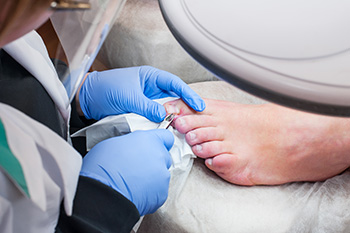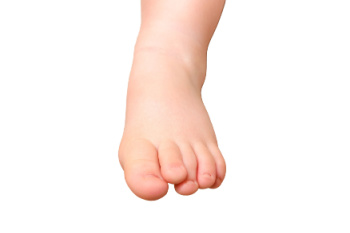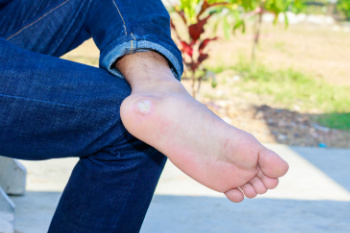Items filtered by date: June 2024
What to Expect From Ingrown Toenail Surgery

Surgery for ingrown toenails is aimed at providing relief and preventing future issues. When conservative treatments fail, a minor surgical intervention can become necessary. During the procedure, a doctor numbs the toe and removes part or all of the affected nail. This process helps to eliminate the pain and inflammation caused by the ingrown nail. After surgery, keeping the area clean and dry is essential to prevent infection. Pain and swelling are usually minimal, and pain relievers can help to manage any discomfort. Most patients can return to their normal activities within a few days, though wearing loose-fitting or open-toed shoes is recommended to avoid pressure on the toe. Proper post-surgical care, including regular follow-up visits, ensures a smooth recovery and reduces the risk of recurrence. If you have an ingrown toenail, it is suggested that you make an appointment with your podiatrist to determine if surgery is right for you.
Foot surgery is sometimes necessary to treat a foot ailment. To learn more, contact Shalonda Davidson, DPM of Instride Carolina Foot Care. Our doctor will assist you with all of your foot and ankle needs.
When Is Surgery Necessary?
Foot and ankle surgery is generally reserved for cases in which less invasive, conservative procedures have failed to alleviate the problem. Some of the cases in which surgery may be necessary include:
- Removing foot deformities like bunions and bone spurs
- Severe arthritis that has caused bone issues
- Cosmetic reconstruction
What Types of Surgery Are There?
The type of surgery you receive will depend on the nature of the problem you have. Some of the possible surgeries include:
- Bunionectomy for painful bunions
- Surgical fusion for realignment of bones
- Neuropathy decompression surgery to treat nerve damage
Benefits of Surgery
Although surgery is usually a last resort, it can provide more complete pain relief compared to non-surgical methods and may allow you to finally resume full activity.
Surgical techniques have also become increasingly sophisticated. Techniques like endoscopic surgery allow for smaller incisions and faster recovery times.
If you have any questions please feel free to contact our office located in Statesville, NC . We offer the newest diagnostic and treatment technologies for all your foot and ankle needs.
Children’s Foot Alignment Deformities
 Pediatric foot alignment deformities are structural abnormalities in a child’s foot that can affect gait and overall mobility. Common deformities include clubfoot, skew foot, and cavovarus. Clubfoot, where the foot twists inward and downward, can be present at birth and may result from genetic factors or in-utero positioning. Skew foot involves a combination of forefoot adduction and hindfoot valgus, leading to a Z-shaped appearance. Cavovarus foot, characterized by a high arch and inward heel, often results from neuromuscular conditions or inherited foot structure. These deformities can affect children of all ages, with risk factors including family history, neurological disorders, and abnormal fetal positioning. Diagnosis typically involves a thorough physical examination, medical history review, and imaging studies such as X-rays or MRI. Treatment varies based on the type and severity of the deformity and may include stretching exercises, orthotic devices, casting, or surgery. Early intervention is imperative for effective management. If your child has a foot alignment deformity, it is suggested that you schedule an appointment with a podiatrist as quickly as possible for an accurate diagnosis and treatment plan.
Pediatric foot alignment deformities are structural abnormalities in a child’s foot that can affect gait and overall mobility. Common deformities include clubfoot, skew foot, and cavovarus. Clubfoot, where the foot twists inward and downward, can be present at birth and may result from genetic factors or in-utero positioning. Skew foot involves a combination of forefoot adduction and hindfoot valgus, leading to a Z-shaped appearance. Cavovarus foot, characterized by a high arch and inward heel, often results from neuromuscular conditions or inherited foot structure. These deformities can affect children of all ages, with risk factors including family history, neurological disorders, and abnormal fetal positioning. Diagnosis typically involves a thorough physical examination, medical history review, and imaging studies such as X-rays or MRI. Treatment varies based on the type and severity of the deformity and may include stretching exercises, orthotic devices, casting, or surgery. Early intervention is imperative for effective management. If your child has a foot alignment deformity, it is suggested that you schedule an appointment with a podiatrist as quickly as possible for an accurate diagnosis and treatment plan.
Congenital foot problems require immediate attention to avoid future complications. If you have any concerns, contact Shalonda Davidson, DPM of Instride Carolina Foot Care. Our doctor can provide the care you need to keep you pain-free and on your feet.
Congenital foot problems are deformities affecting the feet, toes, and/or ankles that children are born with. Some of these conditions have a genetic cause while others just happen. Some specific foot ailments that children may be born with include clubfeet, polydactyly/macrodactyly, and cleft foot. There are several other foot anomalies that can occur congenitally. What all of these conditions have in common is that a child may experience difficulty walking or performing everyday activities, as well as trouble finding footwear that fits their foot deformity. Some of these conditions are more serious than others. Consulting with a podiatrist as early as possible will help in properly diagnosing a child’s foot condition while getting the necessary treatment underway.
What are Causes of Congenital Foot Problem?
A congenital foot problem is one that happens to a child at birth. These conditions can be caused by a genetic predisposition, developmental or positional abnormalities during gestation, or with no known cause.
What are Symptoms of Congenital Foot Problems?
Symptoms vary by the congenital condition. Symptoms may consist of the following:
- Clubfoot, where tendons are shortened, bones are shaped differently, and the Achilles tendon is tight, causing the foot to point in and down. It is also possible for the soles of the feet to face each other.
- Polydactyly, which usually consists of a nubbin or small lump of tissue without a bone, a toe that is partially formed but has no joints, or an extra toe.
- Vertical talus, where the talus bone forms in the wrong position causing other bones in the foot to line up improperly, the front of the foot to point up, and the bottom of the foot to stiffen, with no arch, and to curve out.
- Tarsal coalition, when there is an abnormal connection of two or more bones in the foot leading to severe, rigid flatfoot.
- Cleft foot, where there are missing toes, a V-shaped cleft, and other anatomical differences.
- Macrodactyly, when the toes are abnormally large due to overgrowth of the underlying bone or soft tissue.
Treatment and Prevention
While there is nothing one can do to prevent congenital foot problems, raising awareness and receiving neonatal screenings are important. Early detection by taking your child to a podiatrist leads to the best outcome possible.
If you have any questions please feel free to contact our office located in Statesville, NC . We offer the newest diagnostic tools and technology to treat your foot and ankle needs.
Why Ankles Can Hurt from Running

Running is an excellent way to stay fit, but it can sometimes lead to ankle pain. This discomfort often arises from overuse, improper footwear, or running on uneven surfaces. When you run, your ankles absorb significant impact with each step, which can strain the ligaments, tendons, and muscles around the joint. Overuse injuries occur when the ankle is repeatedly stressed without sufficient rest, leading to inflammation and pain. Wearing shoes that do not provide adequate support or cushioning can worsen this issue, as can running on surfaces that are too hard or uneven, increasing the risk of spraining the ankle. Additionally, biomechanical issues, such as improper running form or flat feet, can contribute to ankle pain by placing extra strain on the joint. To prevent ankle pain, it is important to wear proper running shoes and run on suitable surfaces. If you have developed ankle pain from running, it is suggested that you contact a podiatrist who can guide you toward relief and injury prevention tips.
Sports related foot and ankle injuries require proper treatment before players can go back to their regular routines. For more information, contact Shalonda Davidson, DPM of Instride Carolina Foot Care. Our doctor can provide the care you need to keep you pain-free and on your feet.
Sports Related Foot and Ankle Injuries
Foot and ankle injuries are a common occurrence when it comes to athletes of any sport. While many athletes dismiss the initial aches and pains, the truth is that ignoring potential foot and ankle injuries can lead to serious problems. As athletes continue to place pressure and strain the area further, a mild injury can turn into something as serious as a rupture and may lead to a permanent disability. There are many factors that contribute to sports related foot and ankle injuries, which include failure to warm up properly, not providing support or wearing bad footwear. Common injuries and conditions athletes face, including:
- Plantar Fasciitis
- Plantar Fasciosis
- Achilles Tendinitis
- Achilles Tendon Rupture
- Ankle Sprains
Sports related injuries are commonly treated using the RICE method. This includes rest, applying ice to the injured area, compression and elevating the ankle. More serious sprains and injuries may require surgery, which could include arthroscopic and reconstructive surgery. Rehabilitation and therapy may also be required in order to get any recovering athlete to become fully functional again. Any unusual aches and pains an athlete sustains must be evaluated by a licensed, reputable medical professional.
If you have any questions please feel free to contact our office located in Statesville, NC . We offer the newest diagnostic and treatment technologies for all your foot and ankle needs.
Treating Stubborn Plantar Warts
 Plantar warts are skin growths, typically found on the soles of the feet, that are caused by the human papillomavirus, or HPV. They most often develop on pressure points, such as the heels or balls of your feet. They may cause discomfort or pain when standing or walking. Plantar warts are characterized by a rough, grainy appearance and may have small black dots at the center, which are actually clotted blood vessels. While some warts can eventually clear up on their own, stubborn plantar warts need medical intervention. A podiatrist, or foot doctor, can treat resistant warts using stronger medications like salicylic acid, cryotherapy, laser treatment, or even minor surgery to remove the wart. These methods not only help eliminate the warts, but also help prevent the spread of the virus to other parts of the foot or to other people. If you have plantar warts, it is suggested you consult a podiatrist for an exam and personalized treatment options.
Plantar warts are skin growths, typically found on the soles of the feet, that are caused by the human papillomavirus, or HPV. They most often develop on pressure points, such as the heels or balls of your feet. They may cause discomfort or pain when standing or walking. Plantar warts are characterized by a rough, grainy appearance and may have small black dots at the center, which are actually clotted blood vessels. While some warts can eventually clear up on their own, stubborn plantar warts need medical intervention. A podiatrist, or foot doctor, can treat resistant warts using stronger medications like salicylic acid, cryotherapy, laser treatment, or even minor surgery to remove the wart. These methods not only help eliminate the warts, but also help prevent the spread of the virus to other parts of the foot or to other people. If you have plantar warts, it is suggested you consult a podiatrist for an exam and personalized treatment options.
Plantar warts can be very uncomfortable. If you need your feet checked, contact Shalonda Davidson, DPM from Instride Carolina Foot Care. Our doctor will assist you with all of your foot and ankle needs.
About Plantar Warts
Plantar warts are the result of HPV, or human papillomavirus, getting into open wounds on the feet. They are mostly found on the heels or balls of the feet.
While plantar warts are generally harmless, those experiencing excessive pain or those suffering from diabetes or a compromised immune system require immediate medical care. Plantar warts are easily diagnosed, usually through scraping off a bit of rough skin or by getting a biopsy.
Symptoms
- Lesions on the bottom of your feet, usually rough and grainy
- Hard or thick callused spots
- Wart seeds, which are small clotted blood vessels that look like little black spots
- Pain, discomfort, or tenderness of your feet when walking or standing
Treatment
- Freezing
- Electric tool removal
- Laser Treatment
- Topical Creams (prescription only)
- Over-the-counter medications
To help prevent developing plantar warts, avoid walking barefoot over abrasive surfaces that can cause cuts or wounds for HPV to get into. Avoiding direct contact with other warts, as well as not picking or rubbing existing warts, can help prevent the further spread of plantar warts. However, if you think you have developed plantar warts, speak to your podiatrist. He or she can diagnose the warts on your feet and recommend the appropriate treatment options.
If you have any questions please feel free to contact our office located in Statesville, NC . We offer the newest diagnostic and treatment technologies for all your foot and ankle needs.
